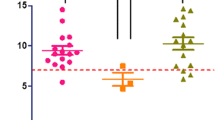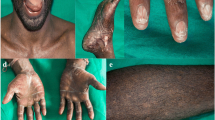Abstract
Dyskeratosis congenita (DC) is a rare-inherited bone marrow failure syndrome associated with multi-system disorder. To summarize the clinical features, epidemiology, and treatment of DC in mainland China, we retrospectively reviewed the medical records of two patients diagnosed with DC at our hospital and published reports on other DC patients in mainland China. The clinical features of 82 DC patients were summarized. The median age of onset was 5 years, but the median age at diagnosis was 16 years. Bone marrow failure occurred at a high rate of 44% and early, with a median onset age of 6 years (range 1–40 years). Only DKC1, TINF2, and TERT mutations were reported, which is a relatively simple signature. Aplastic anemia was treated mainly with low-dose androgens, glucocorticoids, or allogeneic hematopoietic stem cell transplantation, with an efficacy of 39% (14/36). In China, DC is relatively common in infants, with early age of onset but delayed diagnosis. Bone marrow failure occurred at a high rate and early. Improvement in the knowledge and awareness of DC combined with gene mutation tests will facilitate diagnosis and therapy in its early stages.

Similar content being viewed by others
References
Dokal I, Vulliamy T. Inherited bone marrow failure syndromes. J Hematop. 2011;4:53–60.
Fuente JDL, Dokal I. Dyskeratosis congenita: advances in the understanding of the telomerase defect and the role of stem cell transplantation. Pediatr Transplant. 2007;11:584–94.
De BK, Degreef H, Verwilghen R, Corbeel L, Casteels Van DM. Thrombocytopenia: first symptom in a patient with dyskeratosis congenita. Pediatrics. 1981;7:898–903.
Dokal I, Vulliamy T, Mason P, Bessler M. Clinical utility gene card for: dyskeratosis congenita. Eur J Hum Genet. 2011;19:1–11.
Alter BP, Giri N, Savage SA, Rosenberg PS. Cancer in dyskeratosis congenita. Blood. 2009;113:6549–57.
Walne AJ, Dokal I. Advances in the understanding of dyskeratosis congenita. Br J Haematol. 2009;145:164–72.
Nishio N, Kojima S. Recent progress in dyskeratosis congenita. Int J Hematol. 2010;92:419–24.
Killick SB, Bown N, Cavenagh J, Dokal I, Foukaneli T, Hill A, et al. Guidelines for the diagnosis and management of adult aplastic anaemia. Br J Haematol. 2016;172:187–207.
Shimamura A, Alter BP. Pathophysiology and management of inherited bone marrow failure syndromes. Blood Rev. 2010;24:101–22.
Knight S, Vulliamy T, Copplestone A, Gluckman E, Mason P, Dokal I. Dyskeratosis Congenita (DC) Registry: identification of new features of DC. Br J Haematol. 2015;103:990–6.
Doka I. Dyskeratosis congenita. Hematology Am Soc Hematol Educ Program. 2011; 2011:480–6.
Ballew BJ, Savage SA. Updates on the biology and management of dyskeratosis congenita and related telomere biology disorders. Expert Rev Hematol. 2013;6(3):327–37.
Zhang JY, An WB, Zhang L, Chang LX, Qi BQ, Liu TF, et al. Genotype analysis and telomere length measure in patients with dyskeratosis congenita. Zhongguo Shi Yan Xue Ye Xue Za Zhi. 2015;23:212–6.
Liu X, Li XY, Deng WP, Dong X, Zhang QLX, Hu ZZ. Telomere length in patients with dyskeratosis congenita in a Chinese Family. Int J Genet. 2012;35:157–60.
Zhou A, Xia XX, Chen Z, Li FZL, Liang XS. Bone marrow transplantation in the treatment of two cases of dyskeratosis congenita. Zhonghua Xue Ye Xue Za Zhi. 2001;22:407.
Appleyard J, Maden JG. Multidisciplinary teams. Br Med J. 1979;2:1305–7.
Savage SA, Dokal I, Armanios M, Aubert G, Cowen EW, Domingo DL, et al. Dyskeratosis congenita: the first NIH clinical research workshop. Pediatr Blood Cancer. 2009;53:520–3.
Savage SA, Alter BP. Dyskeratosis congenita. Hematol Oncol Clin N Am. 2009;23:215–31.
Dokal I. Dyskeratosis congenita in all its forms. Br J Haematol. 2000;110:768–79.
Kumar S, Suthar R. Dyskeratosis Congenita. Br J Oral Surg. 2013;15:56–8.
Dean A, Alamillos FJ, Velez A, Velasco F, Rodas J, Garcia A. Squamous cell carcinoma of the oral cavity and Fanconi’s anemia. An association to bear in mind. Med Oral. 1999;4:410–5.
Young NS, Scheinberg P, Calado RT. Aplastic anemia. Curr Opin hematol. 2008;15:162–8.
Buchbinder D, Nugent DJ, Fillipovich AH. Wiskott–Aldrich syndrome: diagnosis, current management, and emerging treatments. Appl Clin Genet. 2014;7:55–66.
Fernández García MS, Teruya-Feldstein J. The diagnosis and treatment of dyskeratosis congenita: a review. J Blood Med. 2014; 2014(default):157–67.
Elmahadi S, Muramatsu H, Kojima S. Allogeneic hematopoietic stem cell transplantation for dyskeratosis congenita. Curr Opin Hematol. 2016;23:501–7.
Khincha PP, Wentzensen IM, Giri N, Alter BP, Savage SA. Response to androgen therapy in patients with dyskeratosis congenita. Br J Haematol. 2014;165:349–57.
Agarwal S. Evaluation and management of hematopoietic failure in dyskeratosis congenita. Hematol Oncol Clin N Am. 2018;32:669–85.
Kirwan M, Beswick R, Yulliamy T, Nathwani AC, Walne AJ, Casimir C. Exogenous TERC alone can enhance proliferative potential, telomerase activity and telomere length in lymphocytes from dyskeratosis congenita patients. Br J Haematol. 2009;144:771–81.
Kirwan M, Doka I. Dyskeratosis congenita, stem cell and telomeres. Biochim Biophys Acta. 2009;1792:371–9.
Savage SA, Bertuch AA. The genetics and clinical manifestations of telomere, biology disorders. Genet Med. 2010;12:753–64.
Mason PJ, Bessler M. The genetics of dyskeratosis congenita. Cancer Genet. 2011;204:635–45.
Yamaguchi H, Sakaguchi H, Yoshida K, Yabe M, Yabe H, Okuno Y, et al. Clinical and genetic features of dyskeratosis congenita, cryptic dyskeratosis congenita, and Hoyeraal-Hreidarsson syndrome in Japan. Int J Hematol. 2015;102:544–52.
Xu J, Khincha PP, Giri N, Alter BP, Savage SA, Wong JM. Investigation of chromosome X inactivation and clinical phenotypes in female carriers of DKC1 mutations. Am J Hematol. 2016;91:1215–20.
Funding
This study was funded by Advanced Suitable Technology Popularization Project of Shanghai Health System (Grant number 2013SY073).
Author information
Authors and Affiliations
Corresponding authors
Ethics declarations
Conflict of interest
The authors declare that they have no conflict of interest.
Additional information
Publisher’s Note
Springer Nature remains neutral with regard to jurisdictional claims in published maps and institutional affiliations.
About this article
Cite this article
Li, F., Li, W., Qiao, X. et al. Clinical features of dyskeratosis congenita in mainland China: case reports and literature review. Int J Hematol 109, 328–335 (2019). https://doi.org/10.1007/s12185-018-02582-x
Received:
Revised:
Accepted:
Published:
Issue Date:
DOI: https://doi.org/10.1007/s12185-018-02582-x




